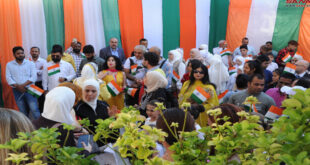Damascus, SANA – The Azm Palace is one of the most important historical structures in Damascus, representing one of the finest examples of Damascene and Islamic architecture in the city.
The site’s director Safa Abu Idris told SANA that the palace was constructed by Asaad Pasha al-Azm, an Ottoman vali (governor), in 1749, picking the location with the care to make use of the economic benefits and political influence of two of the main souqs (marketplaces) of the city, as the palace is located at a vital point between the Umayyad Mosque and the Straight Street/Midhat Pasha Street, a point through which trade caravans passed during that period.
Abu Idris said that historians believe that the palace was built over the ruins of the “golden palace” of Tengiz who was the Mamluk governor of Damascus from 1312 to 1339, which was destroyed by the Mongol invasion led by Tamerlane in 1401. Local traditions say that the golden palace itself was built over the ruins of the “green palace” of the first Umayyad Caliph Muawiyah Bin Abi Sufyan in 680. Going even further back, it is believed that the site rests atop Byzantine, Roman, Hellenistic, Persian, and Early Aramaic ruins.
The director says that Azm Palace is the only remaining abode of the old rulers of Damascus, and that around 800 of the most skilled craftsmen and laborers were recruited to build it over the span of three years over a total area of 5,500 square meters. It is said that the vali’s representatives scoured Damascus, Bosra, and the Levant in general in search of masterpieces in order to decorate the palace with them, with one such example being the Roman columns brought from Bosra.
US anthropologist and archeologist Prof. Cynthia Finlayson said that house building in Damascus all but ceased due to builders and carpenters being drafted to work on the palace, and that even water supplies were cut off until the palace’s water installations were completed.
The palace’s courtyards and their gardens contain a distinct characteristic of Damascene architecture which is water fountains, some of them purely decorative while the others were designed to cool the Iwans (halls with three walls open from one side), while other fountains provided water in reception rooms and bathrooms. Some even were designed with channels in circular patterns in which rose petals were placed to emit their fragrance as the water flowed.
Typically, gardens were a fixture of Damascene houses, and they usually were set as isolated spaces between paved walkways and squares in the courtyard. Damascenes favored fruit trees like lemon, orange, bitter orange, and citron, in addition to fragrant trees and shrubs like cypress and jasmine, in addition to other medicinal and aromatic herbs.
The palace is divided into two parts: the “haramlek” (a word of Turkish origin which mean’s the women’s section) where the family and the female guests of the women of the house stayed, the “salamlek” which roughly means the greeting section where male guests who are not family members and people calling on business were received, and the “khadamlek” which means the servants’ section.
The haramlek consists of two floors and takes up around two thirds of the palace’s area. The second floor was used for sleeping in winter to make used of the heat stored from sunlight, in addition to housing a luxurious bath with a perforated dome letting in light.
According to accounting records dating back to the Ottoman era, over 1,000 trees were used to build the palace, with poplar being used to build the multi-layered and intricately-detailed roof.
Plaster and acacia were used to create embossed decorative surfaces known as “ajami,” with the reception hall having the most richly-decorated roof, along with opulent marble decorations and fountains, because this is where the vali’s guests were received.
Decorations bore Arabic calligraphy, with some of them being verses from the Quran, proverbs, philosophical scripts, or poetry. Meanwhile, crescent patterns are absent in decorations as they had been abandoned at that time.
During the French occupation in 1920, the French general commissioner resided in the palace then he converted it into a research institute. The palace was severely damage by the French artillery shelling in 1925 during the Syrian Revolution, sustaining direct hits which burned and wrecked a large sector of it.
In 1954, the Archeology Directorate renovated the interior and exterior of the palace, restoring it to its former splendor and converting it into a museum. Today, it stands as a testimony to the history of Damascus since the 18th century and a symbol of Damascene architecture, in addition to being a museum of Syrian culture and heritage, making it a vital tourist destination and one of the most important landmarks of the city.
Hazem Sabbagh
 Syrian Arab News Agency S A N A
Syrian Arab News Agency S A N A












